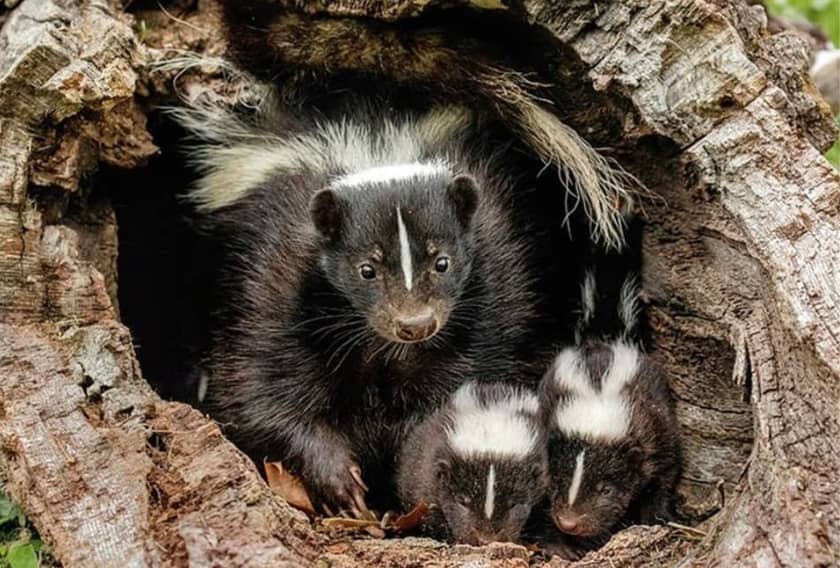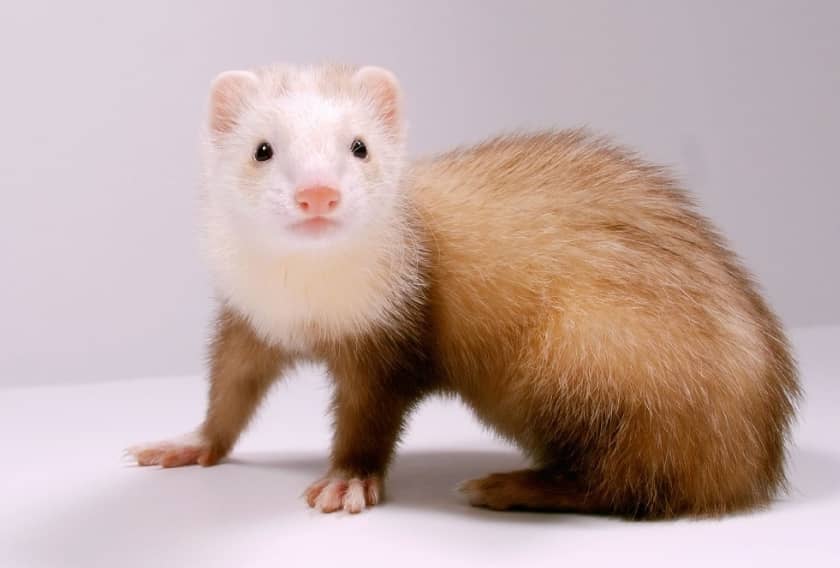Sugar Gliders are little, cute, lively creatures that have become increasingly popular as pets due to their adorable appearance and unique gliding ability. The sugar glider is named for its love of sugary foods such as nectar and sap and its ability to glide through the air.

They have a body similar to that of rodents and squirrels with grey fur and black markings. The coat is thick and soft with colors ranging from blue, grey, yellow tan, or albino.
These small animals are able to glide through the air with a pair of gliding membranes known as patagia which extend from their forelegs to hind legs. These wrist-winged gliders can float on air up to a distance nearly the width of a football field.
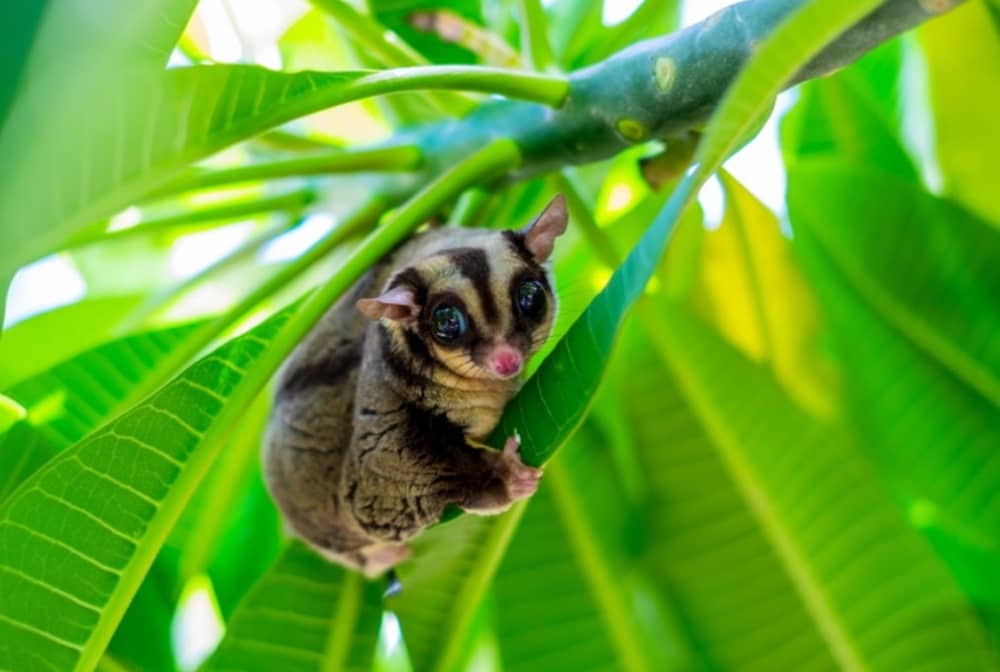
They are known for their lively and social nature. In the wild, they live in colonies and exhibit strong social bonds.
Sugar gliders (Petaurus breviceps) are small, nocturnal marsupials native to Australia, Indonesia, and Papua New Guinea. These arboreal have five digits with an opposable toe on each hind foot which helps them to make a firm grip on the branches. Sugar gliders can alter the tension in their wings and use their long bushy tail as a rudder to steer towards the target. This arboreal locomotion is typically used to travel from tree to tree.
In cold weather sugar gliders will huddle together to avoid heat loss and will enter a torpor in which the body is at a lower temperature with less metabolic activity. Their entering into inactivity is frequent in the wild but not so common in captivity.
Size Information of Sugar Gliders
Sugar gliders are light-weight animals with males having a body weight of 140 g and females with an average weight of 115 g.
Adult sugar gliders are small, typically measuring about 5 to 7 inches in body length, with a tail almost as long as their body. They are approximately 24-30 cm (9 “ to 12”) long.
Male Vs Female Sugar Gliders
Males:
Scent glands are located in a hairless region on the head and chest of males. They have the potential to be more aggressive and may mark their territory and friends more regularly. Males are slightly larger than females.
Females:
To care for their offspring, females develop a pouch. They might be easier to house in couples or groups and are typically less territorial than males.
Behavior and Temperament of Sugar Gliders
Sugar gliders are highly social and require companionship, either from other sugar gliders or their human caretakers. Sugar gliders can learn their name and respond by swiveling their ears.
They are active, curious, and playful.
Their nocturnal nature means they will be most active during the evening and night hours. Sugar gliders make strong bonds with their owners and readily move along with them. Sugar Gliders are social animals that thrive in colonies in the wild. They are highly active at night and require plenty of mental and physical stimulation to stay healthy and happy.
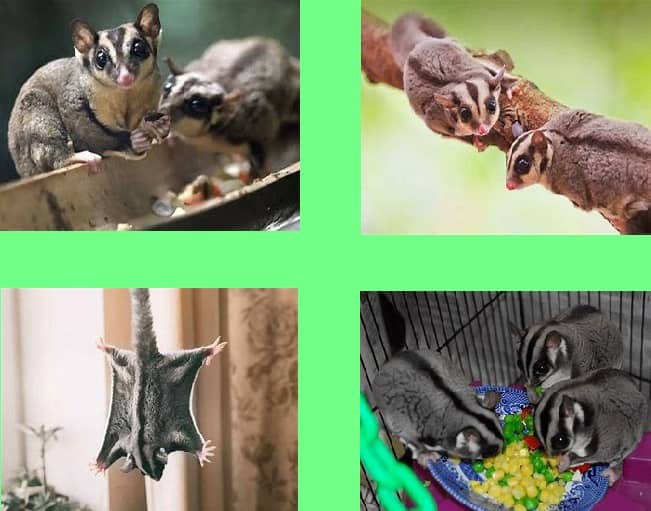
It is crucial to have regular human contact if you want your glider to become attached to you. A simple method to engage with sugar gliders during the day is to let them ride in your shirt pocket. Regular interaction time is required to be spent with your sugar glider else they may develop some symptoms of self-harm and depression.
How to Care for Sugar Gliders?
Ethically, potential owners should consider the commitment required to care for sugar gliders properly. They are not low-maintenance pets and require a significant investment of time and resources.
Housing Requirements
Sugar gliders need a spacious cage to accommodate their active lifestyle. The cage should be at least 36 inches wide, 24 inches deep, and 36 inches tall. Vertical space is crucial as they love to climb and glide. Moreover, the spacing between the cage wires should be no more than 0.5” to make the cage escape-proof. You should also ensure that the cage has horizontal bars to facilitate climbing.
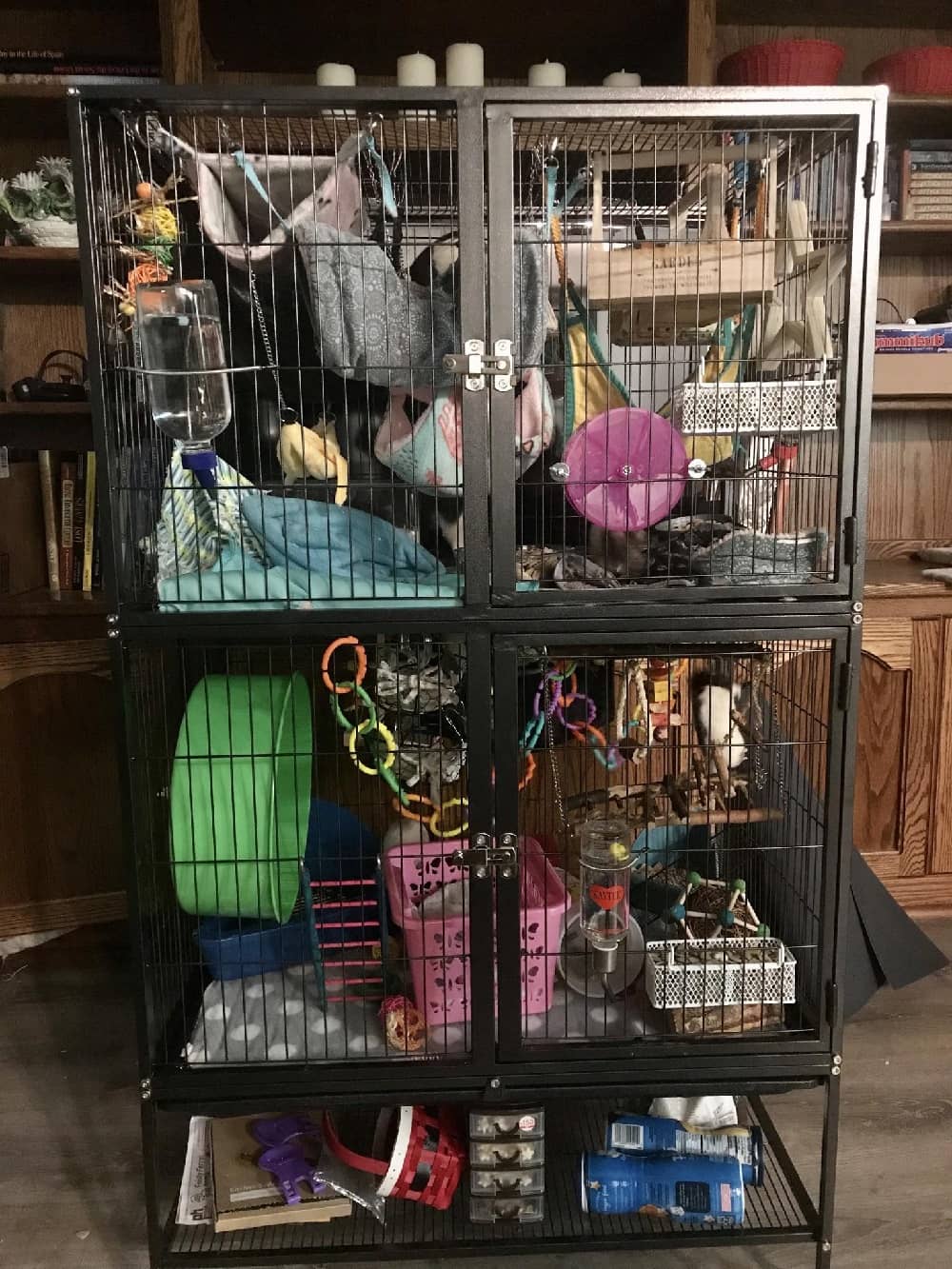
Substrate Needs
A suitable substrate at the bottom of the cage can help manage waste and odors. Options include paper-based bedding, aspen shavings, or fleece liners. Avoid cedar or pine shavings as they can be harmful.
Food or Water Bowl
A balanced diet for sugar gliders includes a variety of fruits, vegetables, proteins, and specialized glider food. The food should be served in a shallow dish which is kept in a corner of their cage. A water bottle or a shallow water dish should be placed inside the enclosure for easy access.

Exercise
Sugar gliders need plenty of exercise to stay healthy. Providing a large cage with branches, ropes, and toys can help them stay active. Allowing supervised out-of-cage time in a safe, enclosed space is also beneficial. An exercise wheel is a good option for providing physical activity. But you need to ensure that the wheel is solid and the tail of the sugar glider doesn’t get stuck anywhere. Hanging bells and bird toys also keep them mentally stimulated. It is possible to mimic the native habitat of sugar gliders, which is Eucalyptus branches and leaves, by adding some Eucalyptus twigs to their enclosure.
You can also add a few drops of Eucalyptus oil to the solution used for cleaning its toys or accessories.

Grooming
Sugar gliders are low-maintenance pets because they do not require much grooming from their owners. It is preferable to hold them using a mitt. Sugar gliders groom themselves, but regular nail trimming is necessary to prevent injury. Their grooming kit should have a nail trimmer and a mitt. It would be best if you use treats and feathers to attract them during ” Tent Time”.
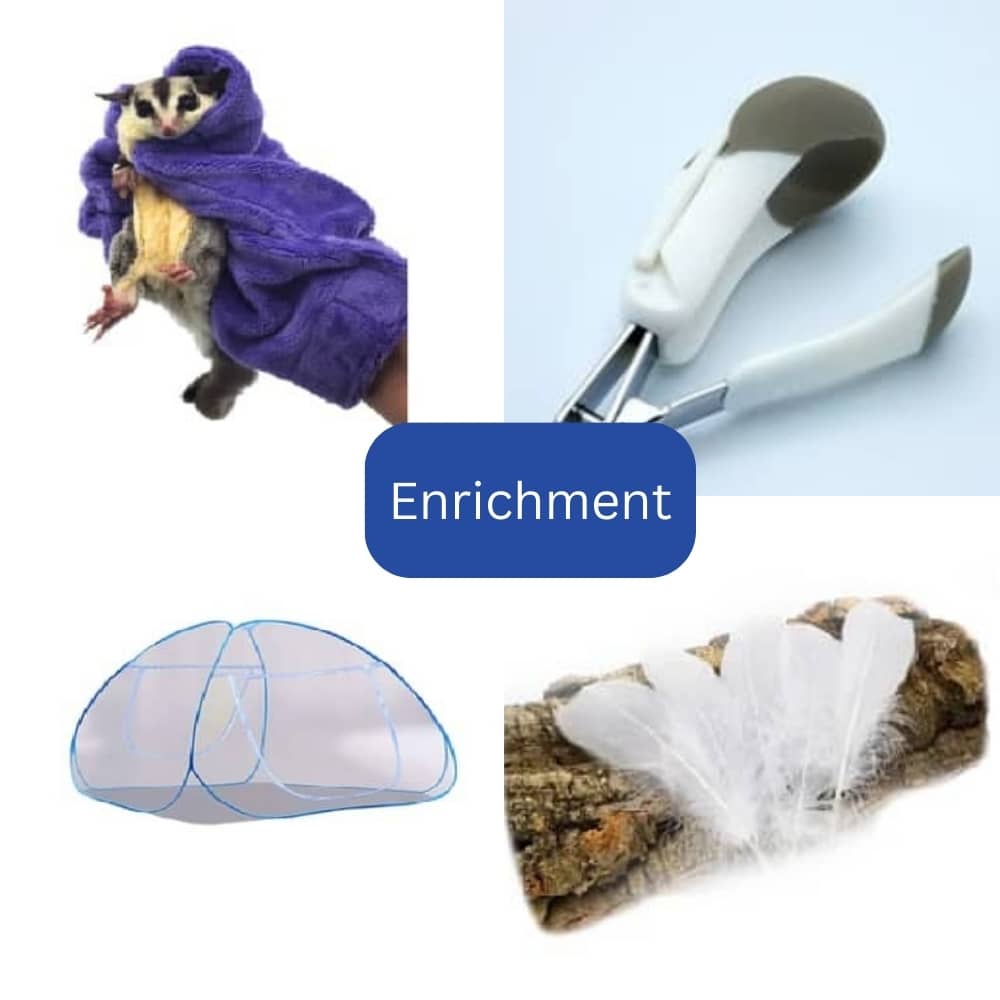
What Does a Sugar Glider Eat or Drink?
Sugar Gliders are opportunistic feeders and change their diet according to the climate. For instance, in summer they mostly rely on insects and in winter they feed on acacia gum, eucalyptus sap, and honeydew. They also prey on lizards, small birds, and eggs.
Balanced Diets
However, in captivity, their diet needs to be a balanced one. You should maintain 50% of their diet as gut-loaded insects that fulfill their protein requirement, 25% fruits, and the rest 25% with vegetables. They enjoy fresh fruits like apples, grapes, and melons, vegetables like carrots and sweet potatoes, and protein sources such as mealworms, earthworms, and boiled eggs.
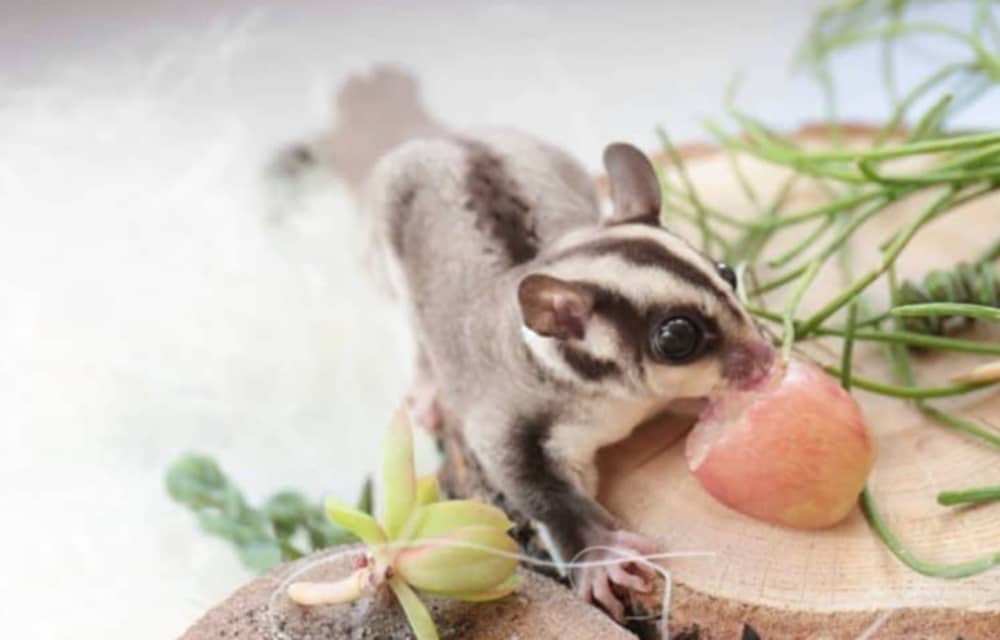
A homemade, Bourbon’s Modified Leadbeater(BML) diet is popular among pet sugar gliders. It contains baby cereals, honey, chicken baby food, and boiled eggs supplemented with calcium powder. The other approved diets can be Critter Love Complete (CLC), or Original HPW (O-HPW), Original High Protein Wombaroo Diet. These diets are high in protein but needs to be supplemented with fruits and minerals.
You can also feed pellets which are available in the market specifically formulated for sugar gliders. These pellets are preferred as wholesome nutrition along with vitamins and minerals can be given to your furry friend. However, due to its basic texture, your pet may get bored of eating it regularly. The best way is to make variations in their diet to cover more nutrient range.
When to Feed?
Many owners serve meals in little food bowls both at night and in the morning. However, some sugar gliders choose to graze instead of finishing their meal in one sitting. Therefore, if there is food left over, don’t worry about it. However, to keep leftovers from rotting, dispose of them before the next meal.
How Much to Feed to Sugar Gliders?
You should consult a veterinarian to set the amount of diet for your pet Sugar glider as it varies as per the age, size, and activity levels. Sugar gliders only weigh between three and five ounces, thus they only need to eat roughly 15-20% of their body weight each day. This amounts to roughly ¼ to ½ of a Leadbeater’s ice cube, a teaspoon of nutritious pellets, and 2-3 tablespoons of fresh fruit, vegetable, and nut mixtures.
Access to Clean Water
You should keep one or two water bottles and a shallow water dish at different locations in their enclosure and refresh them daily.
How to Handle Sugar Gliders?
It takes persistence, delicate handling, and patience to develop a relationship of trust and interaction with a sugar glider. To get them used to your voice, start by spending some time each day close to their cage while speaking softly.

To help the glider get used to your smell and presence, keep it close to you during the day using a bonding pouch or a mitt. You can place a cloth with your smell in the enclosure to acclimatize with your smell.
Prevent Biting
Although it would be tempting to let gliders sniff your fingertips, doing so can make them anxious and even bite. You can prevent biting yourself by clenching your fingers into a fist, which may also help your new pet feel safer. With rewards in hand, slowly extend your hand into their area to foster positive associations.
Careful Lifting
Move carefully and support their body when handling them to make sure they feel safe.Allow the glider to explore you at their own pace, and avoid sudden movements or loud noises that may startle them.
Placement of Cage
To help your gliders become acclimated to regular sounds and voices, it’s a good idea to maintain their cage in the room with the highest activity levels. They’ll adapt and grow to be a member of your family pretty fast.
Tent Time
The finest method to spend the evenings and nights with them is “Tent Time.” All you’ll need are your gliders, toys, goodies, and a tent! You’ll want to settle down on the floor with goodies and toys all around you.
Enriching Environment
Your gliders will begin to investigate and look about. They can try to climb on you or rush up to you. Instead of attempting to hold or pick up your gliders, engage them in conversation with toys and sweets.
Regular pleasant interactions will help your sugar glider develop a sense of trust and bond with you over time, making them more comfortable and affectionate.
Signs of Ill Health of Sugar Gliders
Common signs of ill health in sugar gliders include lethargy, weight loss, changes in appetite, diarrhea, and unusual discharge from the eyes or nose. Regular veterinary checkups are crucial to ensure their health.
Although they are lovely and unusual pets, sugar gliders have particular health requirements and concerns.
- Self-Mutilation: While loneliness, inappropriate handling, and insufficient environmental enrichment can lead to stress-related difficulties like self-mutilation and appetite loss, physical damage from falls or fights can cause broken bones or wounds. Vet care may be required for pouch issues in female sugar gliders.
- Nutritional deficiencies are prevalent. For example, a lack of calcium can cause metabolic bone disease. Poor diets can lead to obesity and a variety of vitamin deficiencies that can impair overall health and weaken the immune system.
- Parasitic Infections: Both internal and exterior parasites, such as worms and mites, can be extremely uncomfortable and sickening. Stress and unfavorable living circumstances are frequently associated with infections, especially fungal and bacterial respiratory infections.
- Dental problems: If you observe inappetence, lethargy, and foul smell from your Sugar Glider’s mouth, then it may be suffering from certain Dental issues. Dental issues, such as growing teeth, can cause discomfort and trouble eating.
A balanced food is high in calcium and protein, a clean and roomy living space, routine veterinary check-ups, and stress-relieving mental stimulation from toys and social interaction are all examples of preventive measures.
To ensure the health and well-being of sugar gliders, it is imperative to keep an eye out for any symptoms of sickness, including dietary changes, weight fluctuations, lethargy, digestive troubles, respiratory issues, and skin lesions. Prompt veterinarian care is also necessary.
Ethics and Legality
Before acquiring a sugar glider, it’s essential to check local regulations, as their legality varies across the United States and some provinces of Canada. It is illegal to keep Sugar gliders as pets in California, Alaska, and Hawaii. However, with permits, these can be kept in various parts of the world such as Victoria, South Australia, Ontario, Manitoba, Sweden, Finland, and New Zealand.
Where to Buy
Sugar gliders can be purchased from reputable breeders, pet stores, or rescue organizations. Ensure the source is reputable and that the animals are healthy and well-cared for. Depending on the sugar glider’s age, color, and pattern, the price can vary significantly. A good breeder will charge you between $350 and $1500 for a healthy newborn sugar glider and between $150 and $1000 for an adult.
Upkeep Cost
Owning a sugar glider involves ongoing costs for food, veterinary care, and supplies. Initial setup costs for a cage and accessories can be around $1000, and monthly expenses will vary but should be anticipated. You may need to spend $500 per year for bedding, veterinary visits, and food supplies.
Reproduction and Breeding
Breeding sugar gliders requires extensive knowledge and experience. Females give birth to one or two underdeveloped young, which then continue to grow in the pouches for several weeks. The gestation period is 15 to 17 days after which a tiny joe(0.2g) will crawl into the mother’s pouch for further development.

Pros and Cons of Keeping a Sugar Glider as a Pet
Pros
- Longer Lifespan gives ample time for interaction
- Highly social and form strong bonds with owners
- Unique and fascinating behaviors
- Low maintenance in terms of cleaning their habitat
- Clean animals
Cons
- Nocturnal nature may not suit everyone
- Requires a significant time commitment for daily socialization
- Need a particular diet
- Not legal to keep them in every state
- Can be prone to health issues without proper care
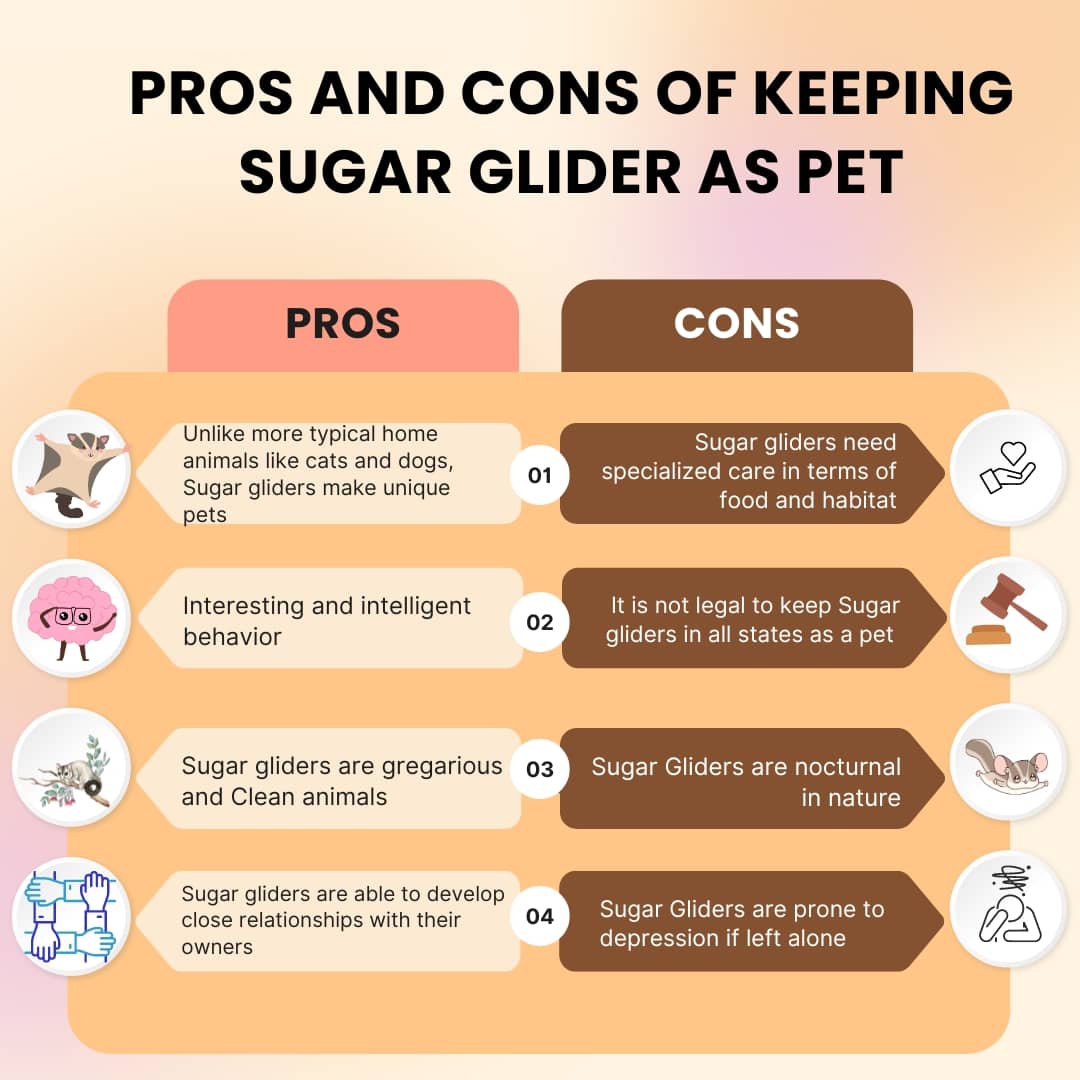
Related Species
Sugar gliders are part of the Petauridae family, which includes other gliding possums like the squirrel glider and the yellow-bellied glider. Each species has unique characteristics and care requirements.
Interesting Facts About Sugar Gliders
- Their scientific name, Petaurus breviceps, means “short-headed rope-dancer.”
- Sugar gliders can glide up to 150 feet using a membrane called the patagium.
- They are nocturnal and have excellent night vision. Male Sugar Gliders have a bifurcated penis to correspond to two uteri of females.
- Female sugar gliders have two ovaries and two uteri.
- Females have a marsupium(pouch in the middle of her abdomen to carry offspring).
- Sugar gliders have a lifespan of 10-15 years in captivity.
- They are social animals and can become depressed if kept alone. They live in colonies consisting of up to seven adults.
- Their diet in the wild consists of sap, nectar, and insects.
- They communicate through vocalizations, visual signals, and scent markings with complex chemical odors.
- Mothers have a scent gland to attract sightless joeys from the uterus.
- The eyes of joeys open around 80 days after the birth.
- Male gliders mark their territory with saliva and a scent produced by separate glands on the forehead and chest.
- Sugar gliders exhibit male parental care.
- Sugar gliders can recognize their owners and form strong bonds.
- They have opposable thumbs, aiding in climbing and grasping.

Frequently Asked Questions
Question1. Do sugar gliders make good pets for children?
Answer: They need a lot of care and attention. Sugar gliders are affectionate and intelligent pets for owners who offer the proper care. Sugar gliders require delicate handling and are not ideal for young children.
Question2. Is it legal to own a sugar glider?
Answer:. It varies by state. You need to check local regulations before acquiring a sugar glider.
Question 3. Can sugar glider be litter-trained?
Answer: They cannot be litter-trained like cats but often choose specific spots for their waste when in the enclosure.
Question 4. Do sugar gliders bite?
Answer: They can, especially if frightened or provoked, but proper socialization reduces this risk. A foreign scent or a human hand can be scary.
Question 5. How expensive are Sugar gliders?
Answer: Sugar gliders are expensive and you may have to spend around $150 to $1500 for an adult or a young one. You should own a pair of Sugar gliders to keep them mentally and physically stimulated.
Question 6. Do Sugar gliders like to be held?
Answer:. Well-socialized sugar gliders like to snuggle and will frequently cuddle up inside a shirt pocket for protection.
Question 7. Can Sugar gliders fly in the rain?
Answer: The Sugar gliders can glide in shower rain.
Question 8. Can I bathe my Sugar Glider?
Answer: No, Sugar gliders are clean animals and do not require any bathing.
Question 9. Are sugar gliders noisy?
Answer: Sugar gliders can be noisy, especially at night, due to their vocalizations and active behavior.
Question 10. Do sugar gliders smell?
Answer: They may smell musky, but this can be controlled with good maintenance and frequent cleaning.

